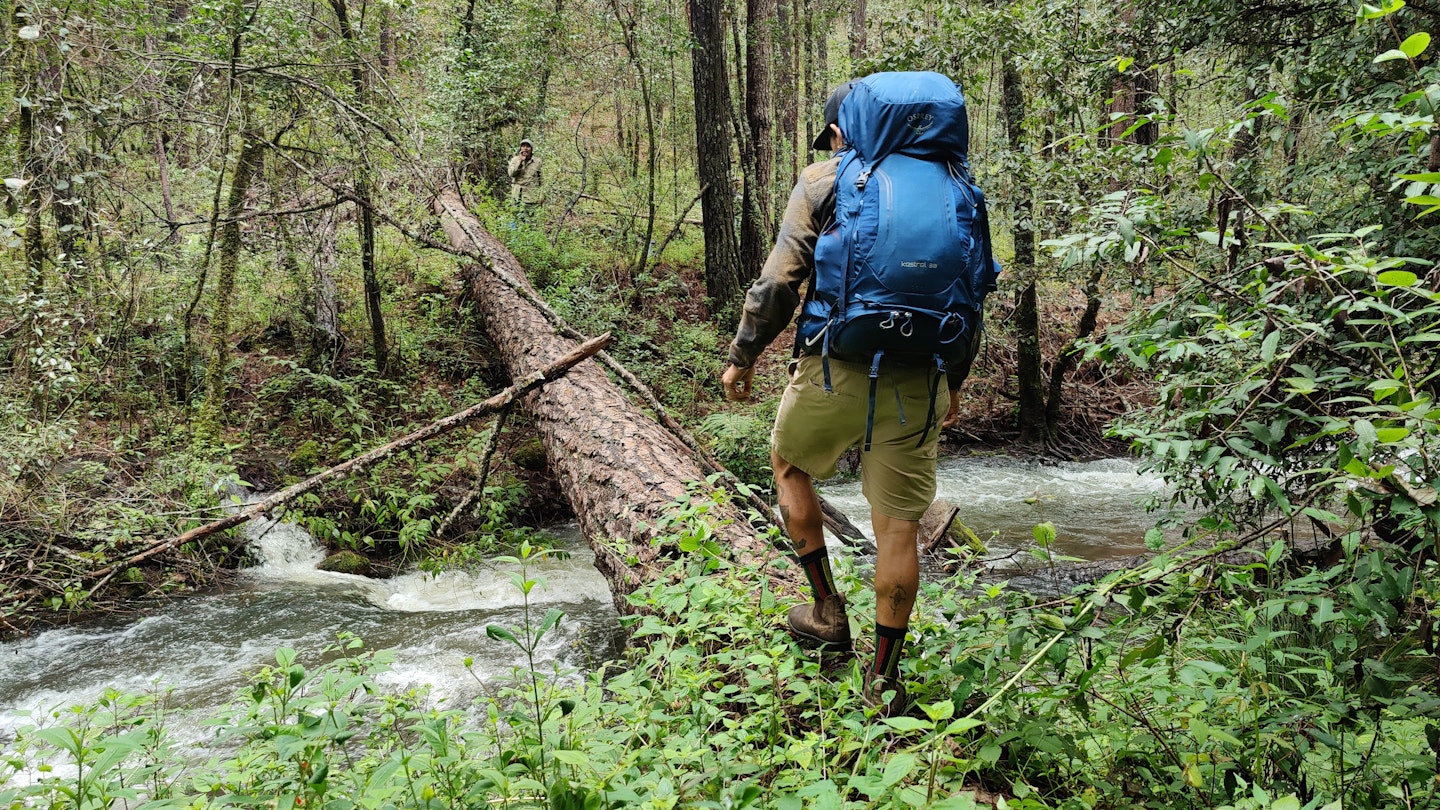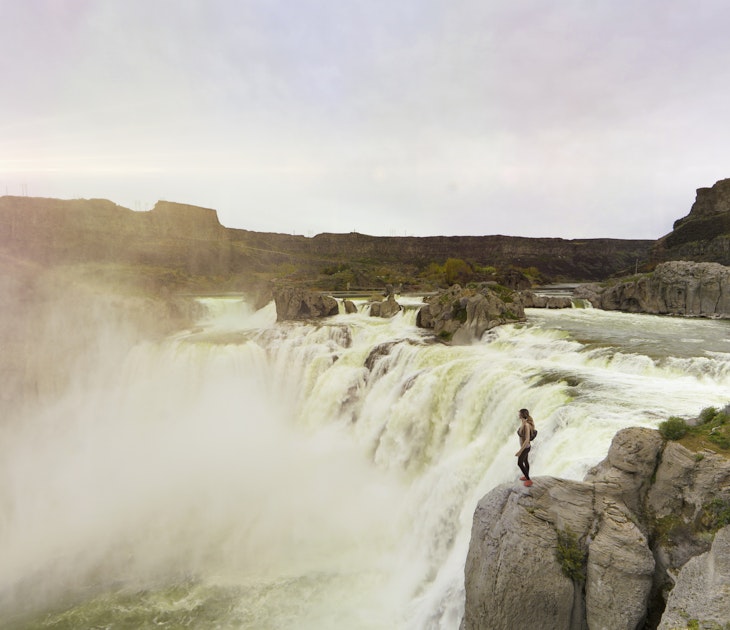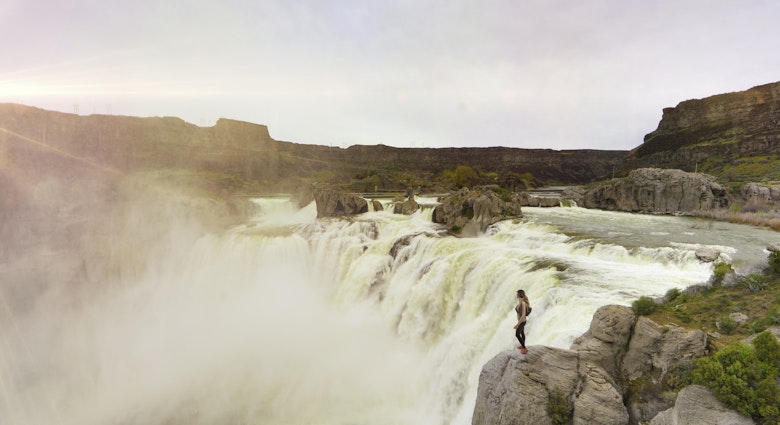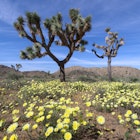Writer Tim Wenger came to Oaxaca in search of mezcal and mole. Thanks to an off-hand recommendation, he ended up deep in the mountains and gained a whole new appreciation for the region.
A field of bright green agave plants stretches across the hillside, dozens of expertly planted rows a quarter-mile long-standing in sharp contrast to the surrounding wild pine forest. The midday sun reveals some letters carved into the skin of one sharp agave branch and I lean in to get a better look. “Aquí estuvo Renada,” it says. “Renada was here.”
I wonder if she was a farmer, putting a knife to a branch, to pass the time. Or maybe, like me, Renada was a visitor, who was surprised to find herself deep in the Sierra Madre mountains of southern Mexico, so far removed from the resort circuit of the Riviera Maya and even the quiet beach towns of Oaxaca, on a historical hiking trail through the high country. While I refrained from adding my own name, I could understand the instinct to do something — anything — to mark the moment.
Oaxaca's signature food and drink do not disappoint
I’d anticipated an abundance of experiences in Oaxaca, but not this. For starters, I figured I’d mostly be interacting with agave in its liquid form, which, to be fair, I’d already overindulged in the night before. I surely hadn’t expected to be working off a mezcal haze out on the same trails once traversed by Zapotec traders and Spanish conquistadors. But at a certain point in any trip, it becomes time to stop expecting and start experiencing.
The state of Oaxaca is rich in coffee, agave and agritourism. This is what brought us here from our home in Colorado. My wife, Alisha, owns a small seed company and is passionate about food systems. She hoped to learn from the region’s growers. Along the way, like most visitors to Oaxaca, Alisha and I wanted to eat mole – the sauce made of rich chocolate and dried chiles often served over chicken or enchiladas – and to sample mezcal, a smoky liquor made from agave plants. Hoping to dive deeper than most visitors, we blocked out a few weeks and rented a small studio apartment a few blocks off the Zócalo square in the state’s capital, Oaxaca City.

Connecting with the land on a network of historic trails
Two weeks into our time in the city, Jair, a bartender at Convivio, a coworking space that doubles as a live venue in the evenings, told us about Coyote Aventuras, an adventure tourism company founded by local mountain bikers Fernando Barnetche and Carlos Hernandez. He explained that its biking and hiking tours aim to preserve a network of historic trails that connect Oaxaca’s remote villages, and in turn, protect a vital piece of the region’s history.
The following morning, groggy from the night before, Alisha and I walked to Coyote’s office on Ruta Independencia and booked a guided hiking tour. Two days later, we headed with a guide and two other travelers into the Sierra Madre mountains. Barnetche and his team add new trail mileage to their system on an ongoing basis, finding old paths that need continuous use in order to remain intact. They also identify business partners in local villages to provide meals, mezcal tastings and cultural experiences to travelers. Coyote currently runs tours on 180 miles of trail throughout Oaxaca’s high country. Despite the company’s efforts, Barnetche believes thousands of trails are yet to be uncovered.
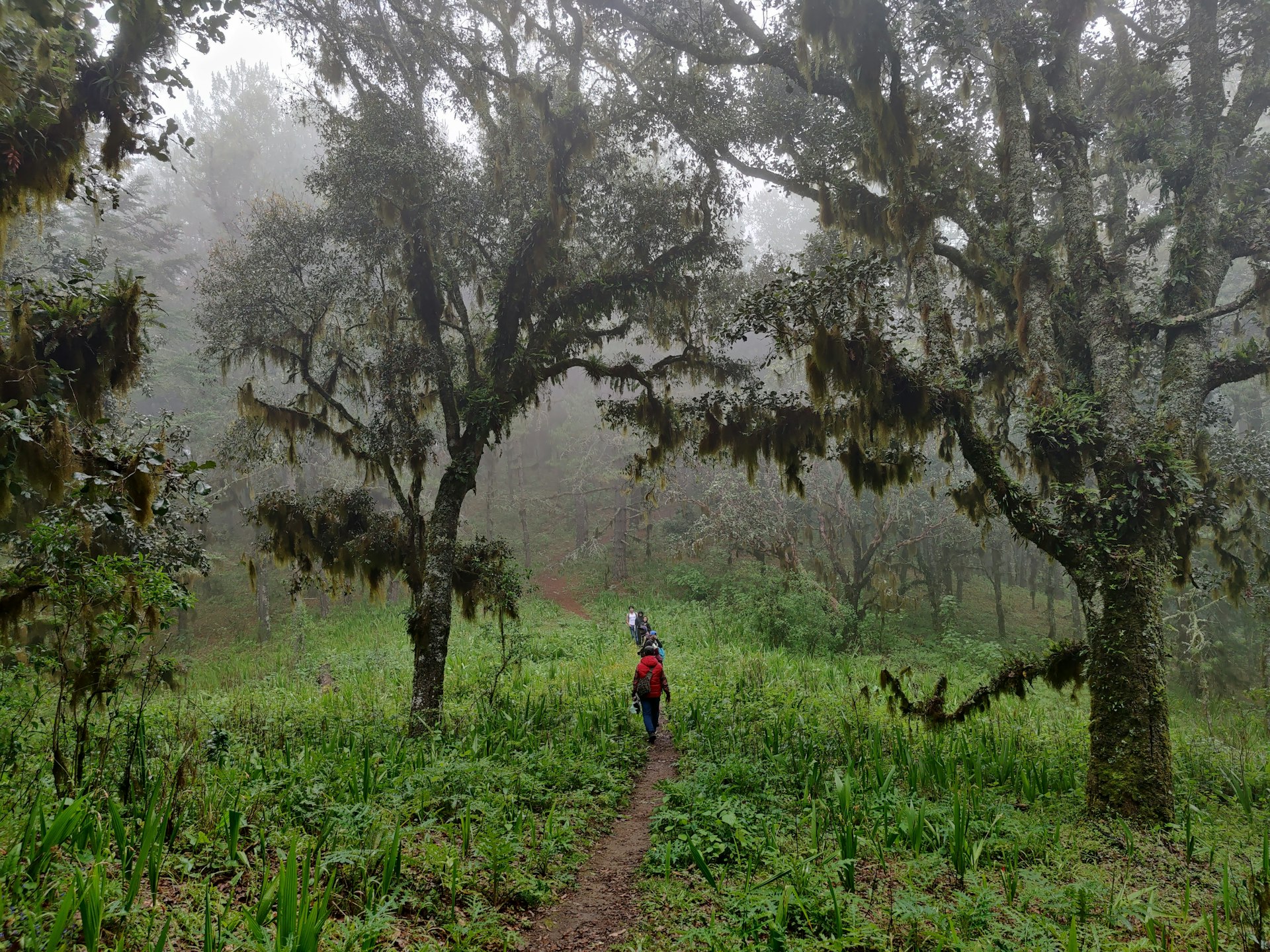
Eighty-five percent of the territory in the southern Mexican state of Oaxaca is rugged, mountainous terrain dotted by small villages. Three distinct ranges – the Sierra Madre del Sur, the Sierra Norte and the Sierra Atravesada – reach above 11,000 feet in elevation, separated by steep canyons and lush valleys home to more than 8000 native species of flora. For hundreds of years, these villages were connected only by rugged trails cut by animals and people moving slowly between them. Barnetche estimates that many of the trails have existed since at least the early 1700s and that others yet to be discovered are likely even older.
As I navigated a particularly tricky section of rock-strewn track, I marveled at the fact that I was walking along a path that may have existed in the time of Cosijopii I, the 16th-century Zapotec ruler of what was then known as the Kingdom of Zaachila. Including the Zapotec, Oaxaca is home to more than one dozen Indigenous nations. Spanish colonizers overtook the region in 1521, bringing with them enslaved people from Africa to work the land. This horrific run lasted 300 years until Mexican independence in 1810. Over that time, hundreds of thousands of Indigenous residents, many of whose ancestors inhabited the area as far back as 2000 BCE, were killed or displaced. It’s a story that many tourists to the region, especially those who spend the bulk of their time in Oaxaca City and popular beach destinations like Puerto Escondido, miss. Walking the very trails where this history unfolded can unlock a deeper understanding of place.
The best national parks in Mexico

Getting off the beaten path and deeper into the country
“One of the most important things we do is that via this company, we are able to bring people to locations that are not visited regularly by tourists,” Barnetche told me. “With this initiative of bringing people to more remote villages, we are able to spread the money in these towns that need it more.”
Barnetche and Hernandez founded Coyote Aventuras in 2017. Their plan was to guide visitors already coming to Oaxaca for the mezcal, food and surf, into the mountains to experience why the Zapotec call themselves the “cloud people.” Frequent rainstorms cast a haze of mist around the pine forests, and snow occasionally blankets the highest peaks. As a result, the hillsides of the Sierra Madre ranges are often lined with mushrooms. The white flowers of the native Cazahuate morning glory grow among thickets of pine, the plant’s bushy base often reaching 10 feet into the air. More than 700 species of birds live in this region, including two we saw on the tour, the rust-colored Bridled Sparrow and the Mountain Trogon, a deep green bird that would have disappeared into its surroundings were it not for the bright red coat over its breast.
Ten places to grab lunch on a budget in Oaxaca

A day of natural springs and natural mezcal
The tour began with a stop two hours from Oaxaca City at Hierve el Agua, a collection of natural springs suspended in travertine rock outside the village of San Lorenzo Albarradas. Despite its name (“the water boils”), the water in these springs hovers around 75 degrees, far too cool for a leisurely soak. After half an hour of walking around the edge of the springs, we hit the trail on foot. It started with a steep descent, with switchbacks winding through the pine forest. After an hour, our guide, Yesi Rojas, stopped the group along a tattered barbed wire fence. We’d reached a fork in the trail. She informed us that here, we would depart from the trail we’d been following. She opened a part of the wooden fencing and instructed us to proceed through, ignoring the bold “no trespassing” signs hung sporadically along the fence.
“We have a deal with the landowner to come on his land,” Rojas said.
A few sharp turns later and the trees gave way to a massive field of agave. The plants’ green arms stretched skyward from the descending slope as far as I could see, the stems of the oldest plants shooting seven feet in the air. The plants, our guide said, were Espadín, the most common type of agave fermented into the mezcal exported internationally, including to the United States.
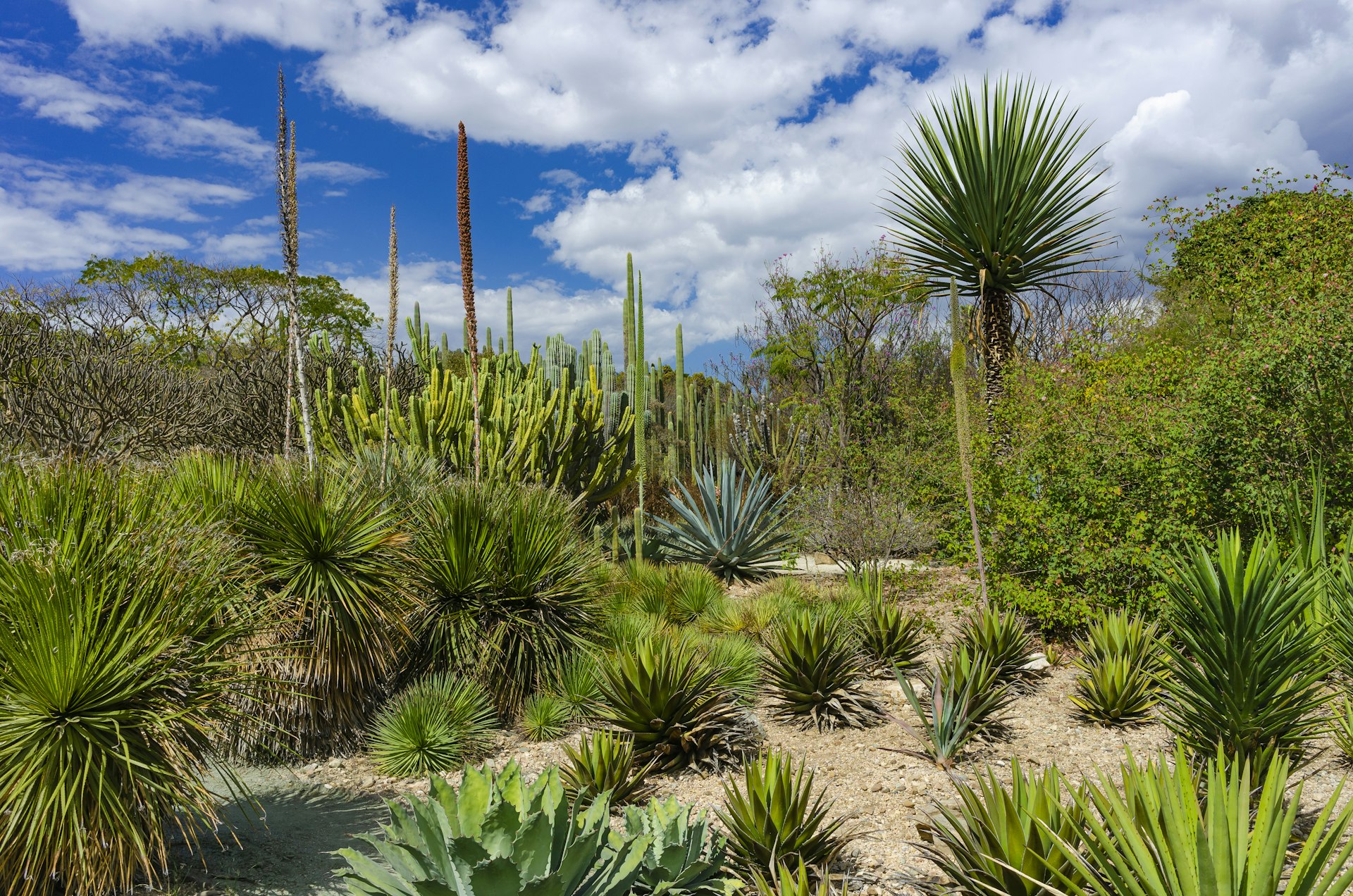
We proceeded another 45 minutes through the mountains to a 20-foot waterfall cascading over the rock into a swimmable pool underneath. We took a quick dip to cool off, and then shuttled from the end of the trail to Gracias a Dios, a palenque, or local mezcal production facility, in the town of Santiago Matatlán. The seven mezcals we tasted progressed in complexity from the smoky-but-easily-palatable Espadín through to the Cuishe, which is fermented with clove and finishes smooth, like an earthy sake. I’d never thought of mezcal as a tropical drink, but hints of lime and even mango stood out in the Tobala and Tepeztate varieties.

The day concluded with a stop at Casa el Encanto, where a traditional Zapotec rug maker was continuing a tradition increasingly threatened by modernity. During a demonstration, a woman named Julia expertly weaved intricate patterns out of wool into rugs and garments. She told us her story of learning the craft from her mother, who had learned from her mother before that. Today, much of her income comes from tourists like us, but she seemed proud to be carrying on the family tradition.
Where to find artisan-produced textiles in Mexico

Adventure tourism as a force for good
The sun had begun to set over the Sierra Madre by the time the tour van pulled back into Oaxaca City. I felt exhausted but inspired. A few days before leaving town, Alisha and I made one final jaunt to the La Cosecha Organic Market. We each lugged home a pound of mole paste and stuffed two liters of mezcal into our packs.
I loved all the mezcal and mole, and they made for good souvenirs. But Jair’s referral to Coyote resulted in a whole new understanding of Oaxaca and its people, one that I otherwise would have entirely missed. It changed the way I view not only Oaxaca but my own travel values. I realized that I thrive off of being both surprised and immersed. It’s a far better use of my time to devote my energies to better understanding a place and its people, even if that understanding will always be incomplete.
“As time has passed, people are more aware of the possibilities of going to further away, remote places,” Barnetche told me. “This will enrich the communities. It protects the traditions. If we can be part of that formula, to have a positive impact in their lives, that is our biggest motivator.”
You might also like:
Mexico's best off-the-grid-beaches
Everything you need to know before shopping for Mexican folk art
From beach to city: Oaxaca's best LGBTQ hotspots
Safety recommendations and restrictions during a pandemic can change rapidly. Lonely Planet recommends that travelers always check with local authorities for up-to-date guidance before traveling during Covid-19.
